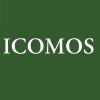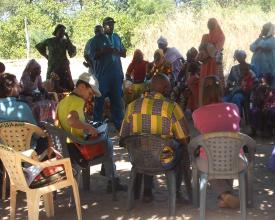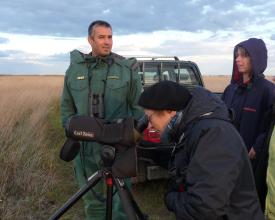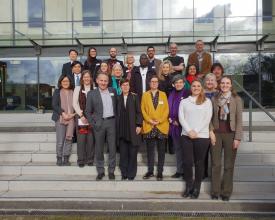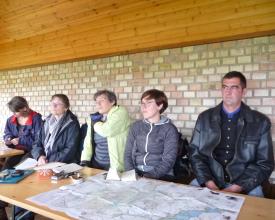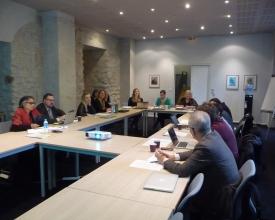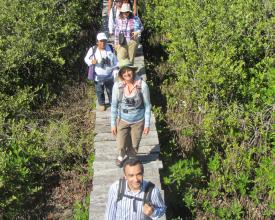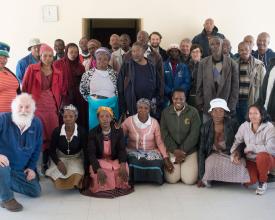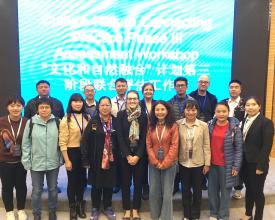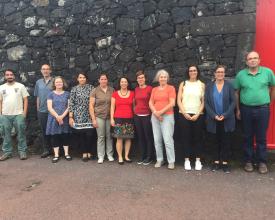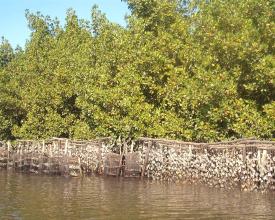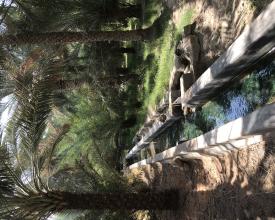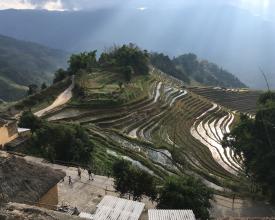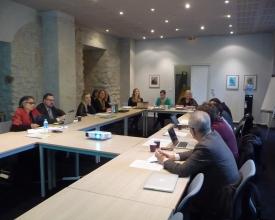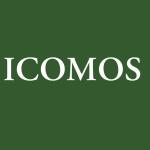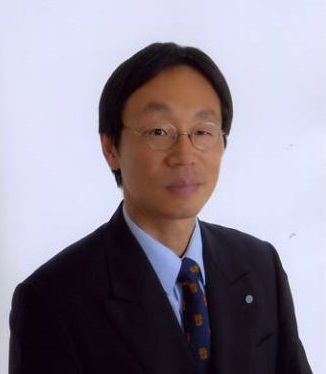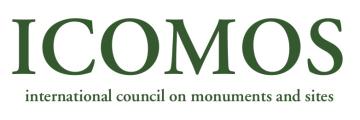
Projet "Connecting Practice" : combler le fossé entre la nature et la culture dans le patrimoine mondial

Depuis 2013, l'ICOMOS et l'UICN mènent Connecting Practice, un projet conjoint visant à développer de nouvelles méthodes et stratégies de conservation qui reconnaissent et soutiennent le caractère interconnecté des valeurs naturelles, culturelles et sociales des sites du patrimoine mondial. Le projet vise à développer des stratégies pratiques pour une approche de conservation plus intégrée et à améliorer la coordination et approfondir la collaboration entre les secteurs culturels et naturels afin d'obtenir de meilleurs résultats en matière de conservation. Un objectif plus ambitieux est d'acquérir une meilleure compréhension des interconnexions entre la culture et la nature et d'influencer les changements dans les approches conceptuelles et pratiques pour l'évaluation des valeurs, la gouvernance et la gestion dans le cadre de la mise en œuvre de la Convention du patrimoine mondial et au-delà. Ce projet de collaboration est conçu pour tirer des enseignements de la pratique en faisant travailler des équipes interdisciplinaires avec le personnel et les partenaires des sites du patrimoine mondial qui illustrent l'interconnexion du patrimoine culturel et naturel.
Contexte
Défis à relever
L'une des principales difficultés réside dans le fait que chaque bien possède des valeurs naturelles, culturelles et sociales uniques, et que les cadres de gestion, de gouvernance et de conservation dépendent du cadre et de l'organisation de chaque site. Garantir une vision holistique de toutes les valeurs (VUE et autres valeurs) et des attributs/caractéristiques au niveau du site et de l'institution est souvent un défi.
Connecting Practice suit une approche d'apprentissage par l'expérience, en créant des expériences courtes et intenses pendant les visites sur le terrain. Il est souvent difficile de créer des ressources accessibles contenant des informations et des connaissances produites collectivement lors des visites sur le terrain. Garantir une interaction respectueuse et égale et des opportunités d'apprentissage pour les participants au travail sur le terrain et aux visites de sites implique l'inclusion des autorités locales, des points focaux nationaux, des gestionnaires de sites et des collègues issus des milieux du patrimoine naturel et culturel.
Le retour d'information indique que le projet suscite de grandes attentes et la gestion de ces attentes croissantes sera un défi pour les phases futures du projet.
Emplacement
Traiter
Résumé du processus
La solution passe par une collaboration accrue entre les communautés et les organisations pour " combler le fossé " entre les valeurs culturelles et naturelles et encourager une gestion holistique, une gouvernance et des stratégies de conservation sur les sites du patrimoine mondial.
Une coopération accrue et des partenariats internationaux renforcés, en particulier pour l'ICOMOS et l'UICN (BB1), avec des termes de référence communs, des visites de terrain combinées et un rapport final commun, encouragent l'interaction nature/culture aux niveaux international et local.
L'utilisation d'équipes diverses (BB2), comprenant des représentants de l'ICOMOS et de l'UICN, des partenaires locaux et régionaux, des gestionnaires de sites et des groupes communautaires, favorise un réseau de coopération et élargit le champ de la discussion.
Le travail collaboratif sur le terrain favorise une intégration accrue de divers groupes (BB3), créant une compréhension plus holistique des sites tout en soutenant le développement de stratégies de gestion améliorées et en créant des approches plus collaboratives de la culture et de la nature à tous les niveaux.
Le commentaire sur les mots-clés (BB4) soutient le travail collaboratif en créant des termes et des concepts généralement acceptés. Cela permet d'éviter les malentendus résultant de la diversité des significations dans les différentes disciplines, ce qui entrave une approche commune de la compréhension.
Blocs de construction
Renforcer les partenariats entre l'UICN et l'ICOMOS et d'autres institutions
Connecting Practice est le premier projet géré conjointement par l'ICOMOS et l'UICN dans le cadre de la Convention du patrimoine mondial. Il promeut la collaboration pour l'interconnexion nature/culture au niveau institutionnel afin d'encourager des approches plus holistiques et intégrées de la gestion et de la compréhension des sites. L'utilisation de visites conjointes sur le terrain a constitué un changement distinct par rapport aux missions précédentes de l'ICOMOS et de l'UICN, permettant une approche plus expérimentale de la compréhension de l'interconnexion. Cela a impliqué des équipes de terrain avec des représentants de l'ICOMOS et de l'UICN, la création de termes de référence communs, la planification et l'organisation coordonnées des visites de sites, et la préparation d'un rapport final combiné, ce qui a permis d'améliorer la collaboration entre l'ICOMOS et l'UICN au niveau institutionnel et local.
La phase III a impliqué la FAO et son projet sur les systèmes de patrimoine agricole d'importance mondiale. Cela a permis de créer d'autres réseaux et de renforcer l'intégration entre les acteurs internationaux, et d'explorer les synergies potentielles avec d'autres désignations internationales en examinant deux biens qui étaient à la fois des GIAHS et des sites du patrimoine mondial. Il en a résulté une discussion plus riche et un échange professionnel sur les priorités et les systèmes communs de conservation et de gestion, les défis et les réponses susceptibles de se renforcer mutuellement.
Facteurs favorables
Assurer un dialogue ouvert et un partage d'informations entre tous les partenaires et collaborateurs est un élément essentiel. Dans Connecting Practice, la participation et le leadership de l'ICOMOS et de l'UICN, ainsi que l'engagement actif des réseaux internationaux du patrimoine naturel et culturel dans tous les aspects du projet, contribuent aux dialogues sur le patrimoine mondial et aident à créer des instruments opérationnels à travers les réseaux professionnels et les organisations individuelles.
Leçon apprise
Les principaux enseignements sont les suivants
1. la création de termes de référence et d'objectifs communs
2. l'utilisation d'une visite commune pour tous les participants (y compris les représentants de l'ICOMOS et de l'UICN, les points focaux locaux, les gestionnaires de sites et les autres partenaires institutionnels)
3. la création d'un rapport final collaboratif pour maintenir un échange de connaissances juste et équitable entre les secteurs nature/culture et les collègues locaux et internationaux ;
4. l'assurance d'un mélange équitable d'expertises diverses en matière de culture et de nature et de participants ayant une connaissance précise du système du PM, y compris de la gestion des sites locaux.
Le renforcement des réseaux de dialogue et de coordination encourage une évolution durable de la pensée et des changements d'attitude et de pratiques, en particulier dans les domaines institutionnels de l'ICOMOS et de l'UICN.
Constitution d'équipes internationales interdisciplinaires et pluridisciplinaires
L'utilisation de ces équipes interdisciplinaires et multidisciplinaires crée des dialogues plus riches et élargit le champ de la discussion dans un projet tel que Connecting Practice, tout en mettant l'accent sur les différents contextes et approches des pratiques de conservation et de gestion.
À toutes les étapes de Connecting Practice, des efforts ont été déployés pour élargir les équipes de travail sur le terrain afin d'inclure des participants aux profils professionnels et éducatifs variés, notamment des archéologues, des agronomes, des architectes paysagistes, des géographes, des écologistes, des anthropologues, des géologues, des spécialistes des sciences naturelles et sociales. Dans la plupart des cas, ces professionnels ont déjà travaillé ou collaboré avec l'UICN et l'ICOMOS, souvent dans le domaine du patrimoine mondial. Chaque phase a collaboré avec des gestionnaires de sites, des organisations locales du patrimoine et des représentants nationaux/régionaux.
La phase III en particulier a impliqué des groupes plus importants de praticiens et de partenaires internationaux dans des domaines contemporains afin d'étudier de nouvelles facettes de l'interconnexion entre la nature et la culture et de construire des alliances à travers les programmes internationaux du patrimoine. Des professionnels engagés dans le programme GIAHS, à savoir un ingénieur agronome et un écologiste, ont été intégrés aux équipes de travail sur le terrain.
Facteurs favorables
Le succès de cette composante dépend de l'interaction directe et cohérente entre les partenariats et les relations pluridisciplinaires et interdisciplinaires. Il s'agit notamment de veiller à ce que les points focaux et les experts locaux soient directement impliqués ; d'utiliser les ateliers comme plateformes de discussion, de retour d'information continu sur les activités et de réflexion sur les enseignements tirés ; de créer des termes de référence communs pour favoriser la collaboration ; de participer au travail sur le terrain et aux discussions lors des visites sur place ; et de collaborer à la rédaction d'un rapport final commun.
Leçon apprise
- La diversité des participants et des partenaires, y compris des représentants locaux, des gestionnaires de sites et des experts, permet une discussion holistique et significative ainsi qu'une meilleure compréhension du site.
- Des équipes diversifiées apportent des points de vue variés et de nouvelles perspectives qui enrichissent les discussions et contribuent à créer une image plus dynamique et holistique d'un bien sélectionné.
- Les ateliers encouragent la collaboration, la discussion et l'interaction. Outre les ateliers internationaux "Connecting Practice", les réunions sur site ont été utilisées pour favoriser une discussion plus large et des résultats plus diversifiés.
- Les termes de référence communs élaborés avant le travail sur le terrain permettent de se concentrer sur des résultats et des objectifs spécifiques. La rédaction de rapports communs encourage la discussion collective et collaborative entre les membres de l'équipe, ce qui permet aux participants d'exprimer des points de vue divergents et de soutenir un produit final commun et accepté.
- Les synergies et les défis identifiés pour une approche harmonisée de la conservation du site doivent être partagés et échangés de manière collaborative et égale entre tous les groupes pour permettre un apprentissage collectif.
Explorations de terrain sur les sites du patrimoine mondial
Le travail sur le terrain a été l'activité centrale de toutes les phases de Connecting Practice, poursuivant l'objectif de reconnaître les points communs, d'établir des liens et de combler le fossé nature/culture. Au cours des trois phases, le travail sur le terrain s'est concentré sur l'engagement au niveau des sites avec les communautés, les gestionnaires de sites, les praticiens du patrimoine et les décideurs politiques.
Le projet a testé différentes méthodes de visites sur le terrain. Les visites de la phase I étaient de nature exploratoire et utilisaient une variété d'approches et de méthodes de travail sur les sites. La phase II s'est concentrée sur la création d'une structure cohérente et commune pour le travail sur le terrain afin d'identifier les stratégies permettant de générer des bénéfices immédiats pour les sites. La phase III s'est concentrée sur la promotion d'approches bioculturelles pour la gestion et la conservation de paysages culturels en constante évolution, sur la traduisibilité de la "résilience" dans les réponses de gestion et sur l'utilisation de partenariats plus larges pour accroître le caractère multidisciplinaire du projet.
Les visites sur le terrain sont essentielles pour comprendre les sites, créer des liens et modifier les pratiques, chaque phase fournissant des leçons et des thèmes pour les phases suivantes. Les résultats du travail sur le terrain permettent de tirer des leçons pour le développement de cadres et de stratégies améliorés, applicables à un plus grand nombre de biens et d'organisations du patrimoine mondial.
Facteurs favorables
Les missions conjointes avec la participation de l'ICOMOS et de l'UICN, la gestion locale du site, les représentants nationaux/locaux et les collègues ayant des formations et des expériences professionnelles diverses, garantissent un large examen des interconnexions naturelles, culturelles et sociales au niveau du site. La planification et la préparation communes, les discussions interactives et les ateliers sur le terrain, ainsi que la rédaction d'un rapport final commun et collaboratif favorisent l'intégration et la participation de tous les membres de l'équipe.
Leçon apprise
Il est essentiel d'identifier et de sélectionner les sites appropriés pour l'étude et les essais. Le site doit présenter de fortes valeurs naturelles et culturelles et disposer des ressources et de la volonté nécessaires pour accueillir une équipe lors d'une visite du site. Une préparation technique et logistique minutieuse et détaillée est nécessaire avant, pendant et après la visite. En outre, cette préparation doit être adaptée et appropriée à chaque site.
Pour que le travail sur le terrain soit couronné de succès, il faut une équipe dévouée qui se concentre sur l'apprentissage et la compréhension des valeurs et des interconnexions au niveau du site. La sélection de coéquipiers pluridisciplinaires et interdisciplinaires ayant des expériences professionnelles et éducatives diverses, ainsi qu'une compréhension de base du système du patrimoine mondial, est nécessaire.
La clarification des attentes concernant ce que le travail sur le terrain peut et ne peut pas accomplir est une leçon importante apprise. Le travail sur le terrain de Connecting Practice est expérimental en ce sens qu'il teste des idées, des méthodes et des approches par le biais d'exercices, mais il n'est pas conçu pour mener des recherches approfondies sur le terrain ou pour fournir une assistance technique. Il est important de le préciser à tous les participants.
Création d'un glossaire
L'approche multidisciplinaire adoptée par Connecting Practice, qui fait appel à des représentants d'organisations du patrimoine naturel et culturel, ainsi qu'à des partenaires locaux et internationaux, a mis en évidence les différences d'interprétation et de compréhension de la terminologie et des concepts applicables. Dans de nombreuses situations, des concepts apparemment similaires ont accumulé des significations légèrement différentes en fonction de leur contexte. La terminologie et les concepts utilisés dans un domaine disciplinaire ont des significations différentes dans d'autres ou, inversement, des termes ou des notions distincts dans un domaine jouent une fonction similaire dans un autre. L'application de vocabulaires multiples peut entraîner des confusions et des malentendus qui peuvent entraver l'utilisation mutuelle des disciplines.
L'établissement d'une base commune pour la terminologie a été identifié comme étant utile pour l'intégration des concepts et des pratiques afin d'assurer une utilisation et une compréhension collectives. Pour répondre à ce besoin, le commentaire sur les mots-clés nature-culture est né du travail effectué dans le cadre de Connecting Practice. Il s'agit d'une compilation de termes et de concepts répartis en trois groupes (approches bioculturelles, résilience et connaissances traditionnelles), dans le but de créer une compréhension commune et une utilisation collective pour aider les activités futures du projet.
Facteurs favorables
Cette étape a nécessité l'identification et la limitation des mots-clés à quelques termes distincts pour la recherche, qui ont ensuite été regroupés en "grappes" thématiques. Cela a permis de mettre en évidence les liens et les chevauchements. L'étude des origines et des significations des concepts, ainsi que de leur utilisation dans différents domaines d'étude, a permis de mieux comprendre leur complexité. En tant que "travail en cours", le Commentaire est flexible et ouvert aux modifications, aux compléments et à l'expansion, ce qui est important pour son succès.
Leçon apprise
Le commentaire a été compilé dans le but de créer un glossaire utilisable de termes et de concepts communément compris pour les travaux futurs. Le défi était double : alors que ces termes sont multidisciplinaires, évoluent et impliquent des processus complexes pour le patrimoine dans son ensemble, le document doit disséquer suffisamment les couches de significations et de termes pour aider les professionnels dans les aspects conceptuels du travail sur le patrimoine. Le commentaire identifie les nombreuses facettes des termes analysés et les conséquences potentielles d'une utilisation non informée dans le domaine du patrimoine. En développant une base préliminaire sur la signification et les origines de ces termes, le Commentaire vise à créer un échange plus clair entre les disciplines et les professionnels. En tant que document "ouvert" et "intermédiaire", il sera enrichi par des références et des terminologies supplémentaires, et complété au fur et à mesure de l'exploration de nouveaux mots et concepts.
Connecting Practice reconnaît qu'il existe des limites, notamment au niveau de la langue, puisque seules des sources en anglais ont été consultées, ce qui limite l'éventail de termes et de significations que d'autres langues peuvent fournir.
Impacts
L'environnement: Connecting Practice met l'accent sur les efforts de collaboration pour mieux comprendre la dualité nature/culture. Les impacts comprennent la révision de la boîte à outils "Enhancing our Heritage" pour inclure les sites du patrimoine mondial culturel et la contribution à la préparation d'un manuel commun pour les biens du patrimoine mondial naturel et culturel. Le projet a eu un impact sur le processus de proposition d'inscription, notamment au stade de l'évaluation préliminaire, où un groupe conjoint ICOMOS-UICN du patrimoine mondial est envisagé.
Social: L'apprentissage par l'expérience s'est avéré précieux pour les participants et a fourni une orientation distincte pour le travail futur, en mettant l'accent sur l'importance de l'interaction humaine et des expériences d'apprentissage collectives et égales au niveau du site. Les diverses équipes de travail sur le terrain ont créé un dialogue plus large avec des avantages tirés d'expériences et de pratiques d'apprentissage mutuel. En tant que groupe de réflexion sur les nouveaux concepts et les nouvelles idées, Connecting Practice a eu un impact positif en testant directement des méthodes de travail et des outils que les gestionnaires de sites pourront utiliser à l'avenir.
L'aspect économique: Un obstacle commun à l'intégration efficace du patrimoine naturel et culturel est la séparation des dispositions institutionnelles. Les résultats du projet dépassent le système du patrimoine mondial et peuvent contribuer à l'intégration des pratiques de gestion nature-culture dans les sites du patrimoine faisant l'objet de désignations multiples.
Bénéficiaires
Les bénéficiaires de cette solution sont les gestionnaires de sites, les communautés locales, les organisations et les experts indépendants impliqués dans la gestion des sites et les visites, les organisations internationales (ICOMOS, UICN, FAO, etc.) et la communauté mondiale du patrimoine mondial.
